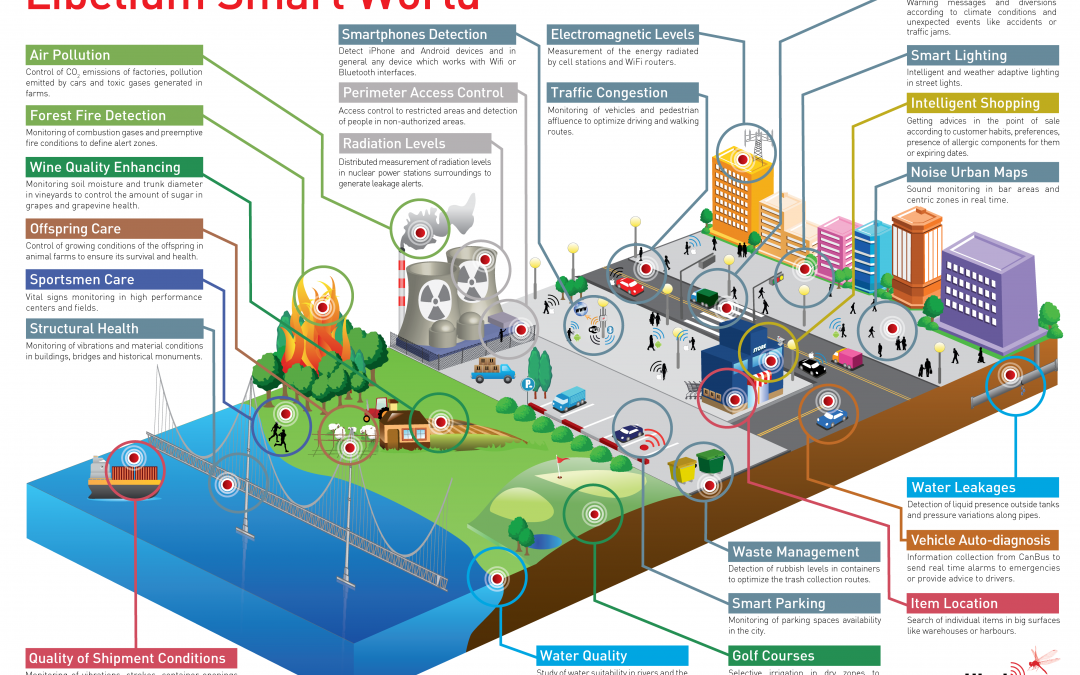Authors: Vincent Dermody (Managing Director, CohnReznick APAC, formerly NOI Strategies) and Max Ryerson (CEO & Chief Digital Strategist, StratForce)
Digital is permeating every aspect of life. Healthcare, retail, transport, communications, government. As digital undergoes continued adoption, it will continue to drive improved communications, real-time access to data and connected products and services (things), and deliver better experiences for all that interact with digitally connected and augmented spaces.
The inevitable future of cities is the sprouting of digital microcosms over urban landscapes, delivering truly seamless experiences across all city services for the myriad of individuals and personae who interact with these environments on a daily basis.
The applications for big data, through to the internet of things in real-time in order to deliver smarter experiences for the city dweller and city managers are on the cusp of booming worldwide. From London – where the city will be introducing the SkyCycle network, transporting bicycles, boxes and energy – to Indonesia, where skyscrapers will power themselves by solar, wind, and geothermal energy – to Dubai, where the city-state has started the implementation of highly connected, real-time city management.
China, meanwhile, is planning to deliver multiple smart cities in the next decade.
While the technology surges of the 20th century focused mainly on accelerating and systemising existing work patterns, the early 21st century is showing a global appetite to reimagine the world in a digitally enabled context. Events as diverse as the GFC and the advent of mobile and wearable technology has given the world the points of inflection to change. Against this backdrop, there has been a slow but steady increase in the interest in Smart City concepts.
To fully understand the dynamics surrounding Smart Cities, first, we need to look at the motive for Smart Cities and why they matter. There are a variety of predictions about population, however, the general consensus is that the global population will reach between 9.5 and 11 billion by 2053. More alarming is the fact that by 2053 75 per cent of the global population will be urban. This means that the global urban population will go from 850 million in 1953 to 7.5 billion in 2053, an increase of over 800 per cent.
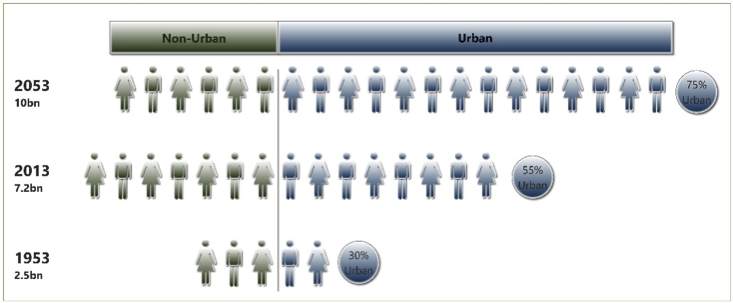
The significance of 1953 is that it represents a post-war era when a majority of global cities concepts such as airports, motorways and subways were established globally. So the city of the future will need to hold 800 per cent more people than the post-war suburbia enabled cities and will need to do so with less consumption of resources per capita, and a lower ratio of non-urban population to support the cities.
While it is futile to predict the technology solutions of the future, it is feasible to look at the problems that need to be addressed. The limitless energy and utility model that underpinned the growth of suburbia no longer exists. This gives some significant points of need in the future. The most obvious of these need orientate around space, transport and power.
These needs require a significant reimagining of the fundamentals of a city.
- Instead of a residential suburb from which people travelled to a commercial or industrial district to work there may be a blended configuration akin to traditional villages.
- Instead of urban transport focused on moving trains to a schedule,
focus will be on moving people in an optimal - Instead of a power grid being built to a peak capacity that only exists for 20% of the time, the grid becomes the source of commodity power, with building contributing power instead of consuming power.
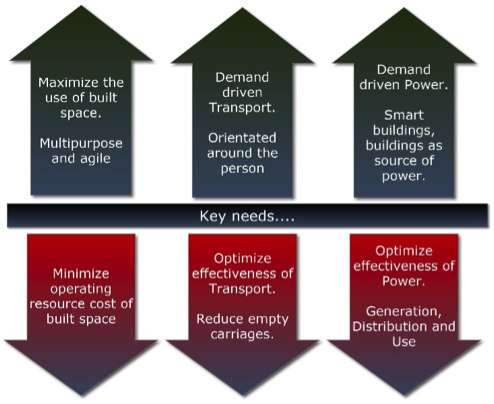
The changes in paradigm
The dynamics of a city will need to move from capability driven to demand driven. These demands will be driven by people to be effected in space to deliver on a purpose. It is here that Digital and Immersed experience will play a vital role.

Business processes or application processes generally refer to systemic steps in managing business information or events, and they tend to be focused on capability silos.
In reality, there are higher order patterns that are typically a user journey or a situation sequence, which are referred to as Meta-Processes.
A person travelling to work each day is a user journey, which has a connection to numerous underlying system processes (ticketing, operations, scheduling and planning).
A heatwave is a situation sequence, which has a connection to numerous business systems (Power Generation, Transport, Health).
In essence, Meta-Processes allow us to draw together the capabilities that exist in separate domains and orientate around the People (User Journey) or Purpose (Situation sequence).
Immersed technology and Digital will be the single point of entry and participation in these Meta-Processes.
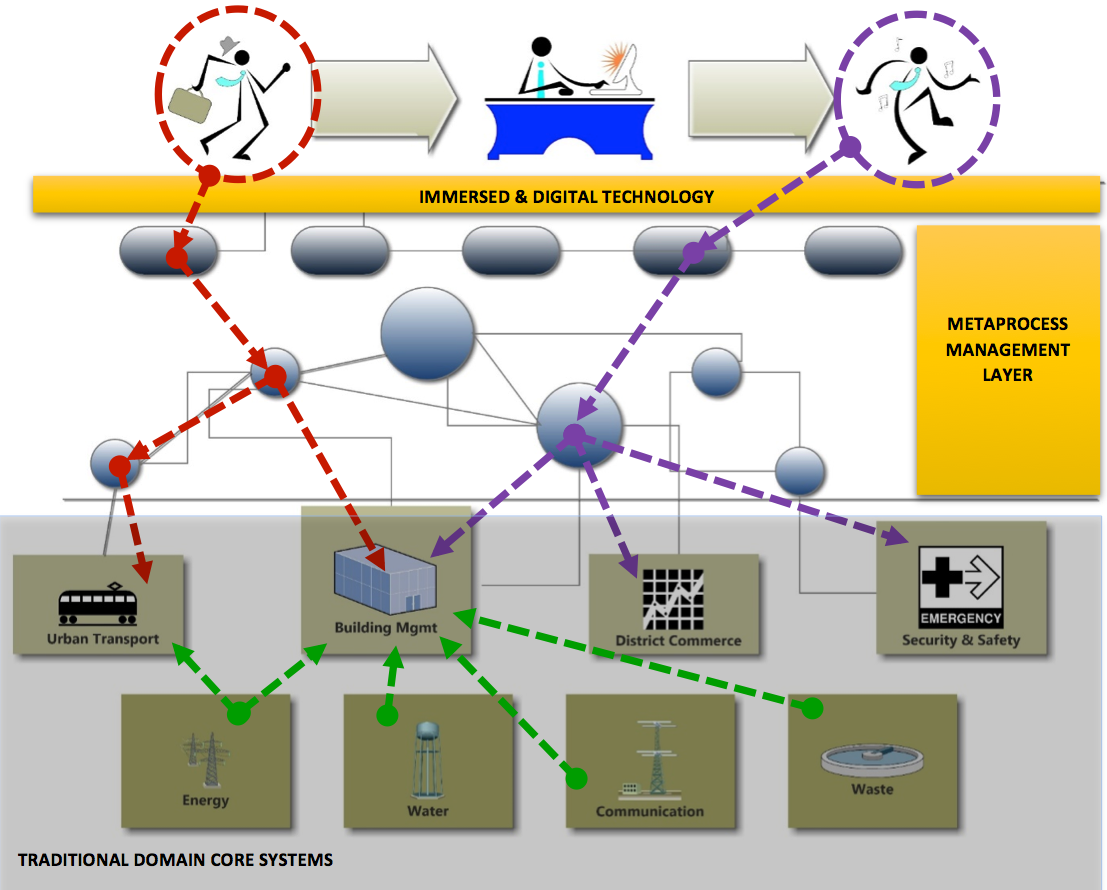
The above diagram shows three user stories or journeys across the top, a man going to work (red lines), a man at work, a man going to a recreational event (purple line).
In each of these stories, the person interacts with a digital or immersed layer. Examples of systems today that are interacting with people in the immersed layer are Apple’s Siri or Ineni Realtime. The key evolution from current experiences will be the seamless interaction with these systems. Instead of “an app for that” there will be more services available in a single immersed experience. This will be a vital evolution away from the current model where mobile apps are extending the reach of the existing domain systems. So instead of the mobile ecosystem being formed by what is available from core systems, the mobile ecosystems will be formed by what is needed for the user journey.
This Immersed and Digital layer will sit on the Meta-Process Management layer which is the key to the evolution. This layer will act as the person or purpose centric integrator of domain systems and services.
Consider the man going to work journey (red line):
- The man opens the Immersed environment on his device, e.g. Siri.
- He says “Travelling to the office at 1 Main Street, leaving now”.
The Meta Process Management layer can now:
- Book the travel,
- Update the demand on the public transport scheduler, and
- Inform the destination building that a person will be there in 30 minutes.
The domain-specific systems can now act on a demand premise:
- Public transport scheduler can dynamically allocate resources to serve demand
- Transport and Building Management Systems can inform of anticipated power demands.
- Building Management Systems can inform of anticipated water and waste
The early examples of this are already underway in London at Heathrow where self-drive pods are planned to shuttle the traveller between the car parks and the airport terminals, which will be rolled out in 2015, and whilst they are not a completely integrated solution as described above, they are certainly a pointer to the future.
The key concept change here is the separation of the domains from the person. A key benefit is the ability to constantly change and extend the meta-processes that support the user experience without having changes reflected into the domains. The harsh reality of successful technology adoption is that it’s about culture as much as technology. People will actively use technology that helps them. People will always orientate to the highest level of service available. For example, transport has to be about moving people not about moving trains, power has to be about enabling people not about generating power.
It is in this context that Digital will move to Digital 2.0. Instead of being an extension of legacy CRM and ERP concepts, it will become the core platform that will be as the custodian of the user journey and experience.
Smart Cities mean a smart future – a future filled with smart experiences and smart environments from the spaces of a retail store to the comforts of your home – each microcosm forming part of the macrocosm of the smart city.
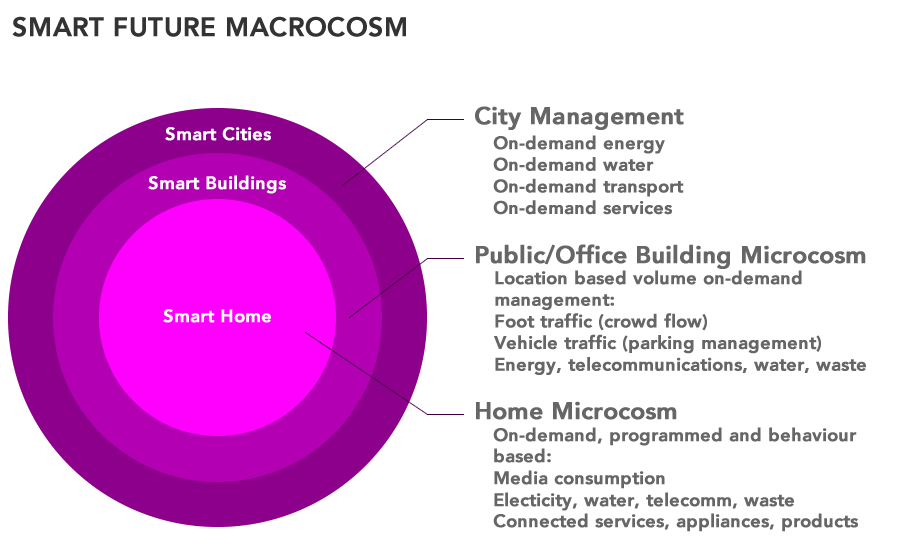
A day in the life of a smart citizen
Picture a person who is just waking up. Their bed has sensed that they are awake and their level of readiness is increasing. They favourite music starts to play softly through their wireless speakers in the room. The room starts to light up slowly and softly moving through a range of cool, warm, fresh colour hues. The electronic tint on the windows softly and slowly changes to reveal the outside world as our CBD worker starts to prepare to get out of bed.
They walk out of their bedroom, during which time the music in the room pauses, the lights switch off, the windows tint continue to decrease to let through natural daylight.
As our CBD worker was about to walk into the hallway, the hallway lights came on. Sensors in the bedroom have sent their data to a cloud-based algorithmic ‘brain’ that has calculated the anticipated probability that the person was about to walk out of the room and into the hallway.
Our CBD worker has now entered the kitchen, which has illuminated itself automatically much
As they approach the pantry cupboard the cupboard door makes breakfast recommendations based on the calendar, activity, behaviour, physical, and food consumption tracking of our CBD worker who has been using wearable technology for the past 18 months: “Hello. I would suggest sliced banana on your muesli this morning. This will help provide you with the energy needed for your day ahead while keeping you on your health goals for this month.” – displays the cupboard door.
With breakfast finished, updated on the latest relevant news, reorganisation of tasks and priorities for the day, our CBD worker heads for the bathroom. Upon leaving the kitchen, lights dimmed and switched off, appliances went into standby mode, and the lights came on in the bathroom. As they entered the bathroom, the room temperature regulated itself to create a comfortable environment. As they disrobe and approach the shower, it knows to switch on at exactly the desired temperature based on the analysis of our users’ past behaviour in setting the temperature for their shower.
As the CBD worker exits their home a self-driving vehicle pulls up in front of their door. The house goes into passive mode, alerting the smart energy grid, the smart transport system, and the smart public safety management system. The house’s proximity locking system engages and locks the house based on the CBD worker’s location out of the house.
Inside the self-driving vehicle, the CBD worker confirms their destination. The estimated travel time will be 15 minutes from the suburban neighbourhood 20km out of the city. The vehicle pulls away while our CBD worker catches up with a work colleague by video call. The vehicle pulls into an efficient flow of traffic, where all vehicles are self-driving allowing for incredible time efficiencies, saving at least 30,000 lives a year, preventing over an additional 2.2 million driving-related injuries annually, and shrinking fuel consumption by 2.4 billion gallons per year.
15 minutes later and the self-driving vehicle pulls into a vehicle parking building, drives to a parking place that was assigned to it by the vehicle parking management system the moment it left the home 15 minutes ago.
The CBD worker has managed to catch up on some of the messages that came in overnight and is now heading towards their office building, travelling through a network of retail and entertainment space, green spaces, and pedestrian walkways. As our CBD worker makes their way through their journey their communication device is guiding them through a recommended path today to make up for the number of steps they didn’t take yesterday to achieve their weekly exercise goals.
They have finally arrived at their office building. Upon entering the building they are guided by their communication device to the appropriate lift to take them to the 64th floor where they work. They have not needed to request the lift to arrive nor have had to push the floor button they needed.
On their lunch break, our CBD worker receives eatery recommendations based on analysing their agenda for the afternoon, the weather, traffic conditions, spending habits, monthly budget, food consumption habits, and their exercise plan. They select a nice little Italian restaurant that is famous for light healthy dishes, prepared quickly, and that is located in a beautiful leafy spot on the waterfront.
It’s the end of the day and our CBD worker has plans to meet up with friends to see the city’s premier football team play their ultimate rivals. Instead of using their self-drive vehicle, our CBD worker hops on a multi-seater self-drive vehicle from a CBD location with their friends and have time to catch up on the way to the stadium.
As they arrive at the stadium, the stadium is intensifying in brightness tinted to the club’s colour, representing the number of the team’s supporters in the stadium. As they are entering the stadium a giant billboard welcomes our CBD worker and their friends by name and the date of when they become a club member. As the match progresses the entire stadium lights up brighter every time the noise level goes up as a result of a goal scored.
It was a great game –
A great night. The drive home is quiet. Our CBD worker doses off. As the vehicle approaches the home, the lights come on and the garage door opens. Once inside the garage and the door closed securely behind them, the vehicle starts vibrating and emitting a soft, consistent and increasing alarm to wake up our CBD worker and alert them that they are home.
The city management side
Now let’s looks at the experience from a macro environment management level:
As the CBD worker starts waking up, the house sensors and cloud-based home ‘brain’ makes requests to the smart city management system for on-demand energy to power-up the home from ‘sleep’ for the next hour while its inhabitant gets ready for work.
It already alerts the system of the likelihood that our CBD worker will be boarding their self-drive vehicle and heading to their place of work in 1 hour and 5 minutes. This information has been collected by analysing the information volunteered by our CBD worker over time, including their diary for the day.
All of this is automated, however, somewhere in a management centre, energy supervisors are monitoring in real-time the demand for energy, seeing real-time projections of anticipated energy consumptions during the coming 24hrs, week, even month, based on shared data (non-identifiable personal diaries, calendar of events, smart homes scheduled activities) and historical behaviour data. Using an augmented reality system, they are able to map, in 3D, a visualisation of the city, overlaying the energy flows, the entire energy grid system, and potential bottlenecks.
Our CBD worker exits their home and is about to board their self-drive vehicle. As they exit the house, the transport network management system accounts for the impending journey that is about to occur, calculating increased traffic density, relaying information back to the vehicle indicating the best route to take. Managing when and where the car will enter traffic, the transport system is managing traffic flow through all routes to the CBD, changing route flow direction and crossroad signals when needed based on volume, and optimising the travel time.
The house has now entered passive mode and the energy management system is now attributing energy to other areas of the city seeing increasing demand. The Public safety management system is now accounting for one more person in motion in the city environment, acknowledging that this person is one more soul to safeguard and allocating the appropriate resources to travel emergencies and destination environment, in this case, the CBD. It is also now actively monitoring the home’s location for any break-ins ready to dispatch appropriate resources.
The transport management system, much like the energy management system, is monitored by transport supervisors capable of witnessing in real-time a 3D visualisation of the city and all its individual transport layers, as well as look and analyse real-time projections of anticipated transport demands. There is a traffic incident currently in progress on the CBD worker’s journey and an automated supervisor is redirecting traffic flow to the CBD. This information is passed on to the vehicle, which is now calculating the best possible route. The CBD worker is unaware of this activity and the ETA does not change.
As the self-driving vehicle approaches the parking facility, the facility’s parking management system detects the vehicle and relays information on parking availability, indicating the best available parking place for the vehicle’s passenger’s ongoing journey. The vehicle now recalculates its final route to the available parking place.
Our CBD worker is now walking towards their place of work. The City’s transport management system’s foot traffic monitor and public safety system have sent information to the CBD worker’s communication device about a theft incident in progress on the route. The device has not only considered the CBD worker’s needs (as outlined above) but also the best rerouting to avoid the incident.
As our CBD worker approaches their office building, the building management system detects and anticipates their entry. It:
- Grants them access through the regular building users doors
- It modifies the air-conditioning demands across the building areas to reflect the addition of our CBD worker to those areas where it knows and will detect the CBD worker
- It adds the CBD worker to the lift scheduling system to streamline their elevator journey
On floor 59, the City’s water management system has detected that a potential problem may be occurring in the near future due to faulty pipes which has the possibility to affect the City’s water management for the area. The system has informed the building’s management system which has dispatched a maintenance officer to the scene. At the indicated location, the maintenance staff is now using augmented reality to analyse the environment, locate the pipes and receive the appropriate information for implementing a solution. They fix the problem before it occurs.
On our CBD worker’s lunch break, the transport management and other city services are informed of the additional transport demand and service requests to manage our CBD worker’s plan to eat out at the desired location: the famous Italian eatery on the waterfront.
The working day is coming to a close. The transport management system is at peak levels managing commuter traffic and transport demands for after work activities. The football match our CBD worker is attending with their friends is a big event this evening with an anticipated 100,000 people filling the stadium and an additional 20,000 people congregating in the area.
The public safety management system is managing resources in real-time, dispatching resources to the area for crowd control, and standing-by additional resources for any crowd activity escalations. With the unusual level of people and activities, the energy management system is responding in real-time to the increased energy needs. So is the water management system as more toilet facilities are being used in a short amount of time.
As our CBD worker and their friends enter the stadium, the building management system has detected their presence and the turnstile gates let them in having identified their proximity. Having ordered drinks, their payment is automatically debited from their primary designated payment source.
Towards the end of the match, the City’s public safety management system has been analysing movement and behavioural patterns amongst stadium patrons. It has detected a pattern indicating imminent skirmish and dispatched the appropriate number of resources to deal with it as soon as it occurs. The supervisors on duty are overseeing 3D real-time visualisation models of the building, surrounding area, and impact on the city if the skirmish was to escalate, preparing for the transport management system and energy management system to respond accordingly.
The skirmish is stopped by a Public Safety Officer almost as soon as it starts. Our CBD worker and their friends are not aware that a skirmish even started. They say their goodbyes and our CBD worker boards their self-drive vehicle that has just arrived.
The City’s transport management system is now accounting for the self-driving vehicle’s journey back to the suburb 20km out of the CBD. Estimated Travel Time: 10 minutes.
Energy demands throughout the city are winding down. Our CBD worker has arrived home safely having consumed just over the legal drinking limit and having been too tired to stay awake on the short trip home.
Last demand on the system: one more citizen in passive mode on the public safety management grid.
As futuristic as this may all seem, a number of these scenarios will take place in 2014 and the next few years while we will achieve the completely connected series of microcosm and live in the macrocosm of smart cities described above in 30-50 years from now.
Considering urban population growth projections for 2050 to equate to 7 out of 10 people living in an urban area, highly efficient smart cities will be a necessity. We can only imagine that this level of sophistication will also make it more enjoyable to interact in the environments that we live in.
And while some may consider some of the proposed visions an invasion of privacy, the majority of these scenarios do not require personally identifiable data.
Here are some videos that give us a taste of the near future to come. Some are older but still valid, some are newer and represent either a vision of the reality to be or the concept of what to expect:
ABOUT THE AUTHORS
Max Ryerson has successfully founded and grown digital companies from scratch to millions in revenue and consulted to major global clients including The Blackstone Group. He has raised capital for
Max Ryerson
CEO & Chief Digital Officer
StratForce
Max.Ryerson@stratforcegroup.com
Vincent Dermody is an Executive Strategy Advisor with an exceptional record for establishing a common vision and vocabulary between business and IT stakeholders. This is backed up by strong delivery of strategic outcomes. He has a reputation of being a pragmatic and outcome-focused strategist, and a “Trusted Advisor” to senior executive audiences, with a solid record of developing high performance teams; including finding, coaching and mentoring of some exceptional IT leadership talent. He has in excess of 20 years been providing IT leadership across Real Estate, Finance, Entertainment, Hi-Tech Manufacturing and Utilities sectors, with market leading skills in Strategy, Architecture and Innovation.
Vincent Dermody
Managing Director
CohnReznick APAC (formerly NOI Strategies)
Vincent.Dermody@ap.cohnreznick.com

